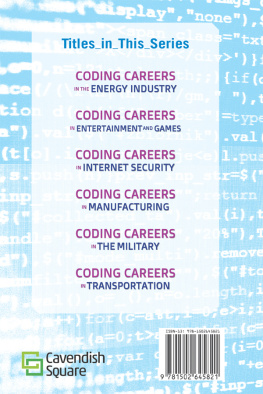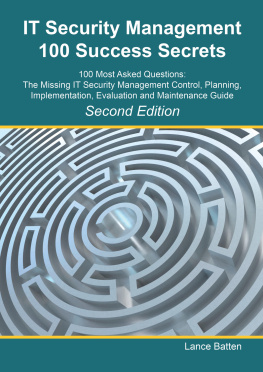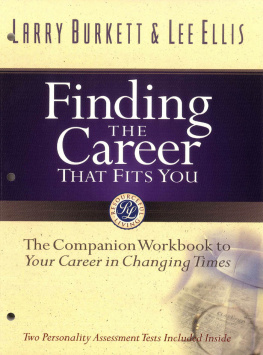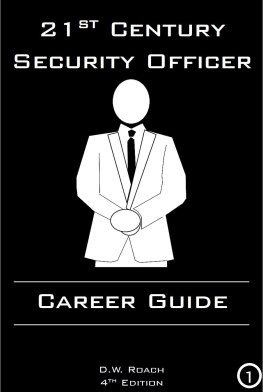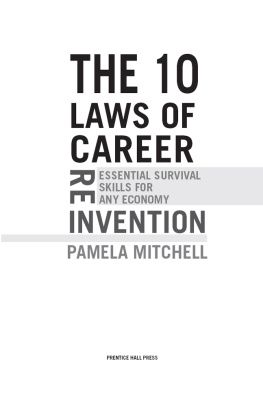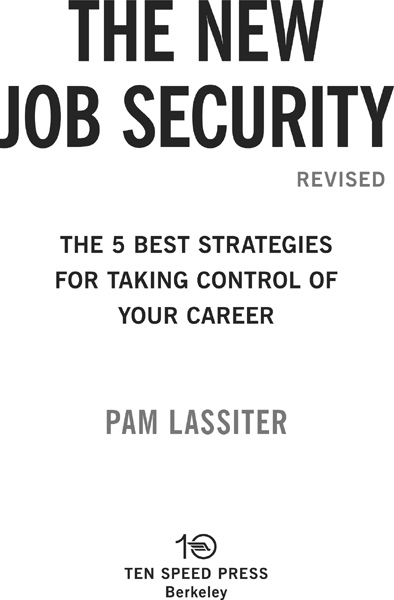CONTENTS
Strategy #1:
Strategy #2:
Strategy #3:
Strategy #4:
Strategy #5:
To Allison and Teel, my shooting stars, burning ever more brightly
To Bic, my strength, one day at a time
ACKNOWLEDGMENTS
This edition of The New Job Security takes a different approach than the last. The former one established five core strategies that allow you to master your career for the long term (okay, you can say forever if it doesnt feel too long), whether youre employed or in transition. The strategies havent changed since then (except for some fresher wording), but the tactics have, and stay in touchtheyll continue to change. I interviewed more than twenty experts for this edition, asking them, How has career management changed in the past five years? Boy, did they have ideas! Youll see them here, integrated into an overall plan of creating satisfying work. I interviewed people from many different groups that will affect your future: human resource professionals, executive search firms and recruiters, experts in social networking, executives at AARP (for retirement trends) and the American Library Association, directors of university career centers, networking mavens, and compensation and legal gurus. Thank you to Ann Anderson, Ellen Mahoney, Fred Foulkes, Deb Cohen, George Davis, Stuart Sadick, Bruce Walton, Susan Hand, Jeff Moore, Jennifer Scott, Robin Talbert, Cathy Ventura-Merkel, Deborah Russell, Kathleen Christensen, Jim Rettig, Kate Brooks, Stacey Rudnick, Chris Sullivan, Virginia Steinmetz, Lauryn Franzoni, Robyn Greenspan, Randy Stevens, Tom Wilson, Philip Gordon, and Jim Hartley. It is because of their openness and sharing that Ive been able to create a template for the future for you. The ultimate thank-you, however, goes to you, the amazing professionals with whom I have worked that are moving up or moving on, who have allowed me to share your journeys and stories. Thank you for your trust.
My supporters for more than twenty years, Dave Opton and Warren Radtke, offer strength in both book writing and life. Dave, your wisdom and research appear throughout this book. Warren, youre always there to keep me grounded and laughing. Who would have guessed that Monty Python is in career counseling? Ken Hablow, youve produced wonderful graphics that magically appear with no notice from me and no moans from you. This book wouldnt have gotten off the ground without all three of you.
Ten Speed Press, you understate the number of gears that you have; you run on at least twenty. Aaron Wehner, publisher, and Julie Bennett, editorial director, you make biking uphill look easy. Not only have you managed an operation well during complex times, but you both recognize the core significance that satisfying work has in our lives. Bravo. Lisa Regul, managing editor at Ten Speed, youre absolutely The Best. Your macrovision, your objectivity, and your ability to put together puzzle pieces transcend anything that I could have done on my own. As the editor for this book, you created a smoother, better oiled machine. Well done. Odds are that without Kara Van de Water and Patricia Kelly, you, the reader, and I wouldnt be meeting right now. Thank you to all.
The final thank-you goes to the worlds best supporting family, Allison, Teel, Jack and Susan, Nancy, and Bic, with hugs and love. Your stars are being hung in the sky right now.
INTRODUCTION
Career Whiplash
Any changes in your work life lately? You might be laughing right now, saying, Where do I begin? Whether youve been let go from your company, chosen to leave, are looking for something new, want to grow within your current company, or just want to hold onto what you have, the dynamics of the job economy have changed dramatically in recent years. Career whiplash is now a preexisting condition for most of us.
Despite this new job economy, with its sharp transitions, intense competition, and high churn rate, too many of us are using old career management skills. Regardless of your age, its easy to have picked up old expectations, old habits, and old mind-sets. If people around us are looking for work, we assume that how theyre approaching it is correct, right? Bad habits are contagious. Ask yourself:
- Do I look primarily for approved job openings, typically through the Internet?
- Do I keep my head down at work, doing my job without tracking marketplace trends and developing skills Ill need to be in demand in the future?
- Do I strategically stay in touch with those in my network and help them even when I dont need anything in return?
- Do I negotiate win-win situations to get the money and working conditions I want?
If you answered yes to the first two and no to the second two, you have old job skills with the attendant career risk. In the new job economy, learning the 5 best strategies will put you out in front, making sure youre in charge rather than unemployed or stagnating. Out in front is where you want to be.
This book is your guide to the new rules for career management. Using current research and information gathered from more than thirty years of experience as a national career management consultant, I have identified and integrated results-driven approaches for people who want to develop their own New Job Security. Contrary to popular opinion, there is job security out there; its location has just moved. The New Job Security is centered in you, not in a company. Its portable.
CREATING YOUR NECK BRACE FOR CAREER WHIPLASH
Its a good thing that job security is portable, because were moving a lot! The statistics in ExecuNets Executive Job Market Intelligence Report (2009) bring home our dramatic lack of stability. Executives expect to hold a job for 5.6 years and end up doing so for only 2.3 years. We think that well work for the same company for 6.6 years, but we remain employed by that company for 2.8 years. What we plan for and what happens are two different things. The call for our own independent plan for job (or career) security is clear. Is the idea that youre in charge new? No. Whats new are the ways that people find jobs, whether they are looking for a new position within the same company or trying to break into a company from the outside. Whats new is the economy, in which youre a hot commodity one year and yesterdays newspaper the next. Whats new are the demographics: boomers are finding themselves searching for jobs at middle age, and Gen Xers are discovering that the start-ups have stopped. Whats new is the idea that not only are you responsible for your own career, but that you actually have a significant degree of control over it. You have the ability to make your own career neck brace that will allow you to observe the rapid changes in the job market but not be subject to their collateral damage.
The experience of working with professionals like youincredibly accomplished people who take the risk of trying new career management strategies to accomplish their professional goals and succeedingis what drove me to write this book. Unfortunately, nobody teaches us career management strategies before we join the workforce and realize we need them to develop our careers. Even if you were lucky enough to pick up some basic strategies in college, those strategies have changed. Mailing your rsum directly to companies youd like to work for and responding to published job openings, which used to be considered best practices, now often result in low yields and a high level of frustration. The good news is that you can change as well, and


